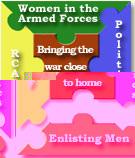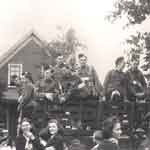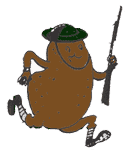

 |
|
 |
|
 Within hours, days, and months many of our men - for only men were allowed in active combat - joined the armed forces. There
was army, navy and air force to choose from. Their first choice was not always where they ended up. When the recruiting officers came to town they looked for suitability and skills for each division.
Within hours, days, and months many of our men - for only men were allowed in active combat - joined the armed forces. There
was army, navy and air force to choose from. Their first choice was not always where they ended up. When the recruiting officers came to town they looked for suitability and skills for each division.
 How to join is now the question. In the early days of the war, Summerside youth wanting to join the air force travelled to the
recruiting office in Charlottetown. Later the recruiters came to them right here in Summerside. Many young men dreamed of
being in the air force for the very newness of aviation made it appear a romantic and dashing occupation. Army
recruiters quickly set up shop in the Armoury on Summer Street. At the beginning of the war men had to be
between the ages of eighteen and forty-five, be in top physical condition and pass a medical exam. Did you know Islanders had
the highest standing in the country for physical fitness? Under the 1940 National Resources Mobilization Act, the government
promised not to force any trained man to serve overseas. Did you know Newfoundland was considered overseas duty? As the war
dragged on and the number of eligible men decreased, the age requirement fell to seventeen and the recruiters weren't quite so
particular. The issue of conscription was raised but in many ways that wasn't where the pressure came from to
join. It was social and peer pressure. The look given on the street or name calling with words
like yellow and zombie had a powerful effect.
How to join is now the question. In the early days of the war, Summerside youth wanting to join the air force travelled to the
recruiting office in Charlottetown. Later the recruiters came to them right here in Summerside. Many young men dreamed of
being in the air force for the very newness of aviation made it appear a romantic and dashing occupation. Army
recruiters quickly set up shop in the Armoury on Summer Street. At the beginning of the war men had to be
between the ages of eighteen and forty-five, be in top physical condition and pass a medical exam. Did you know Islanders had
the highest standing in the country for physical fitness? Under the 1940 National Resources Mobilization Act, the government
promised not to force any trained man to serve overseas. Did you know Newfoundland was considered overseas duty? As the war
dragged on and the number of eligible men decreased, the age requirement fell to seventeen and the recruiters weren't quite so
particular. The issue of conscription was raised but in many ways that wasn't where the pressure came from to
join. It was social and peer pressure. The look given on the street or name calling with words
like yellow and zombie had a powerful effect.
| When you arrived at the recruiting office to enlist the procedure included a medical exam. In the early days of the war it didn't take a whole lot wrong with you to fail. If you didn't pass the medical you were given a rejection pin or Applicant for Enlistment Badge to wear so that no one would call you names. As it became harder to get recruits the doctors weren't as particular and maybe you could make it on the second or third round. |
 "I suppose you are wondering why a handsome, fit gentleman such as myself hasn't enlisted. I'm no yellow-fleshed potato. I served in the First World War, known as the Great War, just over twenty years ago. Perhaps I will enlist in the Veterans Guard, or The Reserve Army, or The Air Raid Precaution Committee, or The Aircraft Detection Corps." After all, my country needs me.
"I suppose you are wondering why a handsome, fit gentleman such as myself hasn't enlisted. I'm no yellow-fleshed potato. I served in the First World War, known as the Great War, just over twenty years ago. Perhaps I will enlist in the Veterans Guard, or The Reserve Army, or The Air Raid Precaution Committee, or The Aircraft Detection Corps." After all, my country needs me.
| There are a number of different flesh coloured potatoes. Be sure to check out the PEI Potato Growers' Association website to see varieties and the importance the potato has played in the history of war. Have you found out from the website how many people potatoes can feed in comparison to the same acreage of wheat? |